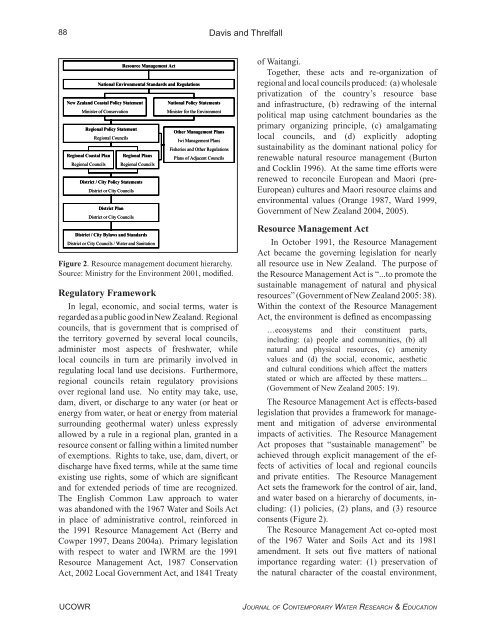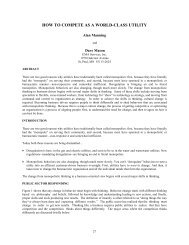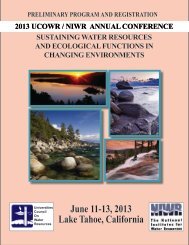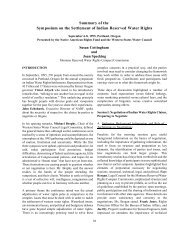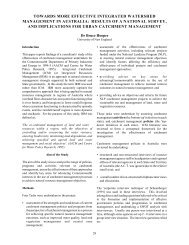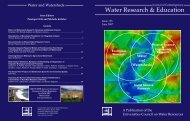88Davis <strong>and</strong> ThrelfallResource Management ActNational Environmental St<strong>and</strong>ards <strong>and</strong> RegulationsNew Zeal<strong>and</strong> Coastal Policy StatementMinister <strong>of</strong> ConservationRegional Policy StatementRegional CouncilsRegional Coastal PlanRegional CouncilsRegional PlansRegional CouncilsDistrict / City Policy StatementsDistrict or City CouncilsDistrict PlanDistrict or City CouncilsDistrict / City Bylaws <strong>and</strong> St<strong>and</strong>ardsDistrict or City Councils / <strong>Water</strong> <strong>and</strong> SanitationRegulatory FrameworkNational Policy StatementsMinister for the EnvironmentOther Management PlansIwi Management PlansFisheries <strong>and</strong> Other RegulationsPlans <strong>of</strong> Adjacent CouncilsFigure 2. Resource management document hierarchy.Source: Ministry for the Environment 2001, modified.In legal, economic, <strong>and</strong> social terms, water isregarded as a public good in New Zeal<strong>and</strong>. Regionalcouncils, that is government that is comprised <strong>of</strong>the territory governed by several local councils,administer most aspects <strong>of</strong> freshwater, whilelocal councils in turn are primarily involved inregulating local l<strong>and</strong> use decisions. Furthermore,regional councils retain regulatory provisionsover regional l<strong>and</strong> use. No entity may take, use,dam, divert, or discharge to any water (or heat orenergy from water, or heat or energy from materialsurrounding geothermal water) unless expresslyallowed by a rule in a regional plan, granted in aresource consent or falling within a limited number<strong>of</strong> exemptions. Rights to take, use, dam, divert, ordischarge have fixed terms, while at the same timeexisting use rights, some <strong>of</strong> which are significant<strong>and</strong> for extended periods <strong>of</strong> time are recognized.The English Common Law approach to waterwas ab<strong>and</strong>oned with the 1967 <strong>Water</strong> <strong>and</strong> Soils Actin place <strong>of</strong> administrative control, reinforced inthe 1991 Resource Management Act (Berry <strong>and</strong>Cowper 1997, Deans 2004a). Primary legislationwith respect to water <strong>and</strong> IWRM are the 1991Resource Management Act, 1987 ConservationAct, 2002 Local Government Act, <strong>and</strong> 1841 Treaty<strong>of</strong> Waitangi.Together, these acts <strong>and</strong> re-organization <strong>of</strong>regional <strong>and</strong> local councils produced: (a) wholesaleprivatization <strong>of</strong> the country’s resource base<strong>and</strong> infrastructure, (b) redrawing <strong>of</strong> the internalpolitical map using catchment boundaries as theprimary organizing principle, (c) amalgamatinglocal councils, <strong>and</strong> (d) explicitly adoptingsustainability as the dominant national policy forrenewable natural resource management (Burton<strong>and</strong> Cocklin 1996). At the same time efforts wererenewed to reconcile European <strong>and</strong> Maori (pre-European) cultures <strong>and</strong> Maori resource claims <strong>and</strong>environmental values (Orange 1987, Ward 1999,Government <strong>of</strong> New Zeal<strong>and</strong> 2004, 2005).Resource Management ActIn October 1991, the Resource ManagementAct became the governing legislation for nearlyall resource use in New Zeal<strong>and</strong>. The purpose <strong>of</strong>the Resource Management Act is “...to promote thesustainable management <strong>of</strong> natural <strong>and</strong> physicalresources” (Government <strong>of</strong> New Zeal<strong>and</strong> 2005: 38).Within the context <strong>of</strong> the Resource ManagementAct, the environment is defined as encompassing…ecosystems <strong>and</strong> their constituent parts,including: (a) people <strong>and</strong> communities, (b) allnatural <strong>and</strong> physical resources, (c) amenityvalues <strong>and</strong> (d) the social, economic, aesthetic<strong>and</strong> cultural conditions which affect the mattersstated or which are affected by these matters...(Government <strong>of</strong> New Zeal<strong>and</strong> 2005: 19).The Resource Management Act is effects-basedlegislation that provides a framework for management<strong>and</strong> mitigation <strong>of</strong> adverse environmentalimpacts <strong>of</strong> activities. The Resource ManagementAct proposes that “sustainable management” beachieved through explicit management <strong>of</strong> the effects<strong>of</strong> activities <strong>of</strong> local <strong>and</strong> regional councils<strong>and</strong> private entities. The Resource ManagementAct sets the framework for the control <strong>of</strong> air, l<strong>and</strong>,<strong>and</strong> water based on a hierarchy <strong>of</strong> documents, including:(1) policies, (2) plans, <strong>and</strong> (3) resourceconsents (Figure 2).The Resource Management Act co-opted most<strong>of</strong> the 1967 <strong>Water</strong> <strong>and</strong> Soils Act <strong>and</strong> its 1981amendment. It sets out five matters <strong>of</strong> nationalimportance regarding water: (1) preservation <strong>of</strong>the natural character <strong>of</strong> the coastal environment,UCOWRJOURNAL OF CONTEMPORARY WATER RESEARCH & EDUCATION
IWRM in New Zeal<strong>and</strong>: Legislative Framework <strong>and</strong> Implementation89Table 1. Activities <strong>and</strong> consents.ActivityDefinitionPermitted No consent is required if the effects comply with the conditions specified in the planning documents.A certificate <strong>of</strong> compliance can be issued by the relevant authority to verify this statusControlled Generally a non-notified application.Consent must be granted, but conditions can be imposedDiscretionary Generally a notified application.Consent may or may not be granted, depending on criteria specified in the planning document.Non-complying contravenes plan, but not a prohibited activity.Notified applicationConsent may be granted or refused.Prohibited Consent cannot be granted in any circumstances.No application permitted.Need a change to the controls to proceedSources: R<strong>and</strong>erson 1997, Harris 2004, Government <strong>of</strong> New Zeal<strong>and</strong> 2005.wetl<strong>and</strong>s, lakes, <strong>and</strong> rivers <strong>and</strong> their margins,(2) protection <strong>of</strong> these areas from inappropriatesubdivision, use, <strong>and</strong> development, (3) protection<strong>of</strong> outst<strong>and</strong>ing natural features, areas <strong>of</strong> significantindigenous vegetation <strong>and</strong> significant habitats<strong>of</strong> indigenous fauna, (4) maintenance <strong>and</strong>enhancement <strong>of</strong> public access to the coastal marinearea, lakes <strong>and</strong> rivers, <strong>and</strong> (5) maintenance <strong>and</strong>enhancement <strong>of</strong> the relationship <strong>of</strong> Maori <strong>and</strong> theircultural traditions with their ancestral l<strong>and</strong>s, water,sites, waahi tapu (sacred sites) <strong>and</strong> other taonga(treasures) (Government <strong>of</strong> New Zeal<strong>and</strong> 2005).The 2004 Resource Management Act Amendmentalso places protection <strong>of</strong> biodiversity as a matter <strong>of</strong>national importance (Government <strong>of</strong> New Zeal<strong>and</strong>2005).Activities <strong>and</strong> ConsentsA regional policy statement, regional plan, ordistrict plan may include control mechanismsthat prohibit, regulate, or allow activities. Thecontrol mechanisms are based on the actual orpotential adverse environmental effects <strong>of</strong> anactivity. Activities may be categorized as permitted,controlled, discretionary, non-complying, orprohibited (Table 1) (R<strong>and</strong>erson 1997, Harris 2004,Government <strong>of</strong> New Zeal<strong>and</strong> 2005).<strong>Water</strong> Conservation Orders are further subdividedinto Preservation Orders <strong>and</strong> ProtectionOrders. Preservation Orders are more restrictive<strong>and</strong> require leaving water in its natural state: nowater, coastal or discharge permit may be grantedthat would alter the water body. Protection Ordersallow activities provided that they allow forprotection <strong>of</strong> the specified “outst<strong>and</strong>ing resource”(Deans 2004b, Government <strong>of</strong> New Zeal<strong>and</strong>2005).National <strong>Water</strong> Policy<strong>Water</strong> allocation <strong>and</strong> management are recognizedas issues <strong>of</strong> regional <strong>and</strong> national importance.Nationally, recognizing an absence <strong>of</strong> nationalguidance, the Ministry for the Environmentinitiated a review <strong>of</strong> water issues as part <strong>of</strong> its“Sustainable <strong>Water</strong> Program <strong>of</strong> Action.” Thirteenactions were identified in 2004 (Table 2) (Ministryfor the Environment 2004). In 2005, the Ministryfor the Environment together with the Minister <strong>of</strong>Agriculture <strong>and</strong> Forestry issued a joint statementon water, including investigation <strong>of</strong> water transfersto encourage increased water use productivity(Ministry for the Environment 2006). A waterpolicy statement on water allocation is expected inthe first half <strong>of</strong> 2007. The statement is not legallybinding but will provide guidance. Regionalplans consistent with national legislation containregulations that must be followed.Implementation <strong>of</strong> IWRMConsequently, implementation <strong>of</strong> IWRM islargely controlled through national <strong>and</strong> regionalpolicy statements <strong>and</strong> rules spelled out in regional<strong>and</strong> district plans. The country is divided into 12regional councils plus five unitary councils thatserve both as local <strong>and</strong> regional government bodies.Each <strong>of</strong> the 12 regional councils is comprised <strong>of</strong>JOURNAL OF CONTEMPORARY WATER RESEARCH & EDUCATIONUCOWR
- Page 3:
Journal of ContemporaryWater Resear
- Page 6 and 7:
2Bruce Hooperinstitutional, and tem
- Page 11 and 12:
IWRM: Governance, Best Practice, an
- Page 13 and 14:
IWRM: Defi nitions and Conceptual M
- Page 15 and 16:
IWRM: Defi nitions and Conceptual M
- Page 17 and 18:
IWRM: Defi nitions and Conceptual M
- Page 19:
IWRM: Defi nitions and Conceptual M
- Page 22 and 23:
18Cardwell. Cole, Cartwright, and M
- Page 24 and 25:
20Mostert26 water boards responsibl
- Page 26 and 27:
22MostertTable 1. Third National Wa
- Page 28 and 29:
24MostertImplementationThe ambitiou
- Page 30 and 31:
26MostertBiswas, A. K. 2004b. Respo
- Page 32 and 33:
28UNIVERSITIES COUNCIL ON WATER RES
- Page 34 and 35:
30Ashton, Turton, and Rouxresource
- Page 36 and 37:
32Ashton, Turton, and Rouxassumptio
- Page 38 and 39:
34Ashton, Turton, and RouxEffective
- Page 40 and 41:
36UNIVERSITIES COUNCIL ON WATER RES
- Page 42 and 43: 38Hussey and Doversin water policy
- Page 44 and 45: 40Hussey and Dovers1994 Council of
- Page 46 and 47: 42Hussey and Doversestablished Thes
- Page 48 and 49: 44Hussey and DoversTable 1. Typolog
- Page 50 and 51: 46Hussey and Doversassessment appro
- Page 52 and 53: 48Hussey and Doverspolicy goals.Bey
- Page 54 and 55: 50Hussey and DoversFrawley, K. 1994
- Page 56 and 57: 52Mitchelloften took three to four
- Page 58 and 59: 54Mitchelltree preservation plans;
- Page 60 and 61: 56UNIVERSITIES COUNCIL ON WATER RES
- Page 62 and 63: 58Genskow and Borna series of chall
- Page 64 and 65: 60Genskow and BornTable 1. Watershe
- Page 66 and 67: 62Genskow and Bornthe first Dungene
- Page 68 and 69: 64Genskow and BornWashington, DC.Ko
- Page 70 and 71: 66Green and Fernández-BilbaoWithin
- Page 72 and 73: 68Green and Fernández-Bilbaosubjec
- Page 74 and 75: 70Green and Fernández-Bilbaoinflue
- Page 76 and 77: 72Green and Fernández-BilbaoBerbel
- Page 78 and 79: 74UNIVERSITIES COUNCIL ON WATER RES
- Page 80 and 81: 76BallweberEstablish AdvisoryCommit
- Page 82 and 83: 78Ballweberattributes in others (Ch
- Page 84 and 85: 80UNIVERSITIES COUNCIL ON WATER RES
- Page 86 and 87: 82Barreiraand ground water. To this
- Page 88 and 89: 84Barreirawith other states for int
- Page 90 and 91: 86UNIVERSITIES COUNCIL ON WATER RES
- Page 94 and 95: 90Davis and ThrelfallTable 2. Thirt
- Page 96 and 97: 92Davis and Threlfallby regional an
- Page 98 and 99: 94Davis and Threlfallenforcement, a
- Page 100 and 101: 96Davis and Threlfallhusbandry prac
- Page 102 and 103: 98Davis and ThrelfallNew Zealand: T
- Page 104 and 105: 100UNIVERSITIES COUNCIL ON WATER RE
- Page 106 and 107: 102Lamoree and van SteenbergenIt is
- Page 108 and 109: 104Lamoree and van Steenbergenand n
- Page 110 and 111: 106Lamoree and van Steenbergeninter
- Page 112 and 113: 108BourgetWorks Planner Capability
- Page 114 and 115: 110Bourgetwith over 600 people resp
- Page 116 and 117: 112Bourgetgovernment’s intrusion
- Page 118 and 119: 114Bourget4.management, drought man
- Page 120 and 121: 116McKayFigure 1. The four paradigm
- Page 122 and 123: 118McKay4. Paradigm 4 (which commen
- Page 124 and 125: 120McKaythree main functions:1. ass
- Page 126 and 127: 122McKayState Implementation of the
- Page 128 and 129: 124McKayTable 2. Corporate governan
- Page 130 and 131: 126McKayFigure 4. Qu. 26 - The ESD
- Page 132 and 133: 128McKayFigure 7. Qu.93- This organ
- Page 134 and 135: 130McKayBrundtland Report. 1987. Ou
- Page 136 and 137: 132UCOWR BOARD OF DIRECTORS/COMMITT
- Page 138 and 139: 134BENEFITS OF UCOWR MEMBERSHIPThe
- Page 140 and 141: 136Past Issues of the Journal of Co
- Page 142 and 143:
138Academic Organizations Membershi
- Page 144 and 145:
140Individual Membership Applicatio
- Page 146 and 147:
Universities Council on Water Resou
- Page 148:
Integrated Water Resources Manageme


